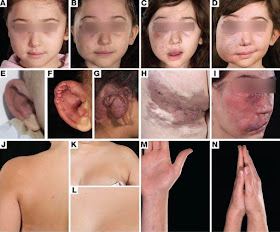Bence Viola from the Max Planck Institute for Evolutionary Anthropology
in Leipzig discovered the tooth fragments together with Russian
colleagues in the Denisova Cave in the Altai Mountains. Initially, he
thought the inconspicuous-looking object was the molar of a cave bear.
But when the remaining fragments of the tooth turned up, it became
obvious that the researchers had found the tooth of a hominid. It was
too large, however, to be from a modern man or Neanderthal. When the
researchers finally succeeded in decoding the DNA of the tooth, their
suspicion was confirmed: it hailed from a previously unknown early human
species living in Asia at least 30,000 years ago.
More on the
Denisovans:
Because of the cool climate in the location of the Denisova Cave, the discovery benefited from DNA's ability to survive for longer periods at lower temperatures. The average annual temperature of the cave remains at 0°C, which has contributed to the preservation of archaic DNA among the remains discovered. The analysis indicated that modern humans, Neanderthals, and the Denisova hominin last shared a common ancestor around 1 million years ago.
The mtDNA analysis further suggested this new hominin species was the result of an early migration out of Africa, distinct from the later out-of-Africa migrations associated with Neanderthals and modern humans, but also distinct from the earlier African exodus of Homo erectus. Pääbo noted the existence of this distant branch creates a much more complex picture of humankind during the Late Pleistocene... David Reich of Harvard University, in collaboration with Mark Stoneking of the Planck Institute team, found genetic evidence that Denisovan ancestry is shared by Melanesians, Australian Aborigines, and smaller scattered groups of people in Southeast Asia, such as the Mamanwa, a Negrito people in the Philippines.
And what a superb cave; no wonder it maintained its real estate value for tens of thousands of years. The narration accompanying the slideshow is concise and superb; this video will be of interest to anyone with even a smidgeon of curiosity about archaeology or human prehistory.
Addendum: To keep relevant material in one place, I'll insert here a post I wrote back in 2011 ("
Denisovan genes as markers of migration") -
There's too much to cover here in a short post, but I'll sketch what I understand as the basics.
Denisovans were ?pre-humans/proto-humans of the genus
Homo who died out as a species. They were
genetically distinct from us, but some of their genes are present in modern humans. The distribution of those genes today is not random, as shown by the figure above.
“We haven’t been a very exclusive species, with a very narrow
origin,” said Martin Jacobsson. Interbreeding with other members of the
human family tree “is not a unique event. It’s a more complex story than
we thought before.”
In a study published Oct. 31 in the Proceedings of the National Academy of Sciences,
Jacobsson and co-author Pontus Skoglund searched through 1,500 human
genome scans from around the world for genes found in Denisovans but not
chimpanzees or Neanderthals.
While the previous finding of Denisovan inheritance involved analysis
of ultra-high-resolution human genome scans, of which only a few exist,
Jacobsson used low-resolution scans. These are more commonly available
and allowed the researchers to detect Denisovan signals in genomes from
mainland southeast Asia. A signal also appeared in South America, but
Jacobsson said that’s probably a false positive.
I'm interested in the South American hits because of my belief in early colonization of the Americas from Oceania. I believe there's good evidence that the
chickens in Chile and Peru came from Polynesia in pre-Columbian times.
Further information at
Ars Technica, via
Right-reading.
DNA from another human-like primate, the Denisovans,
lurks in modern genomes, too. A molar and a chip of pinkie bone found
in a Siberian cave provide what little information we have about this
species. DNA extracted from the fragments previously revealed
cross-species breeding. Yet a new study in the
journal Cell shows
the ancient hanky-panky did not stop in Siberia:
Humans who traveled
across South Asia mated with a separate group of Denisovans, as well.
“This is a breakthrough paper,” said David Reich,
who studies ancient DNA at Harvard University and was not involved with
the study. “It's a definite third interbreeding event,” one that adds
to the previously known Denisovan and Neanderthal mixtures.
Humans and Neanderthals divided into separate groups as far back as
765,000 years ago. Denisovans
and Neanderthals were closer cousins who split more recently and then
vanished — perhaps because we absorbed their lineages...
All groups studied, from British and
Bengali people to Peruvians and Puerto Ricans, had a dense cluster that
closely matched the Altai Neanderthals. Some populations also had a
cluster that matched the Altai Denisovans, which was particularly
pronounced in East Asians.
The surprise was a
third cluster — not like the Neanderthal DNA and only partially
resembling the Altai Denisovans. This, the authors concluded, was a
second and separate pulse of Denisovan genes into the DNA blender.
More at the link.








































